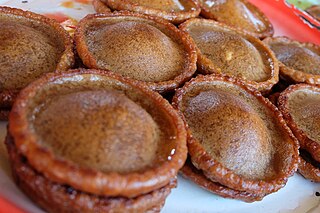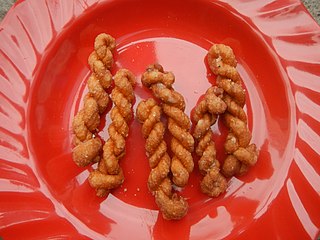Related Research Articles

Satay, or sate in Indonesian spelling, is a Southeast Asian dish of seasoned, skewered and grilled meat, served with a sauce. The earliest preparations of satay is believed to have originated in Java island, but has spread to almost anywhere in Indonesia, where it has become a national dish. Indonesian satay is often served with peanut sauce – a sauce made from ground roasted peanuts, and is often accompanied with lontong, a type of rice cake, though the diversity of the country has produced a wide variety of satay recipes. It is also popular in many other Southeast Asian countries including Brunei, Malaysia, Philippines, Singapore and Thailand. It is also recognized and popular in Suriname and the Netherlands. In Sri Lanka, it has become a staple of the local diet as a result of the influences from the local Malay community.

Glutinous rice is a type of rice grown mainly in Southeast and East Asia, and the northeastern regions of South Asia, which has opaque grains, very low amylose content, and is especially sticky when cooked. It is widely consumed across Asia.

Zamboanga Peninsula is an administrative region in the Philippines, designated as Region IX. It consists of three provinces including four cities and the highly urbanized Zamboanga City. The region was previously known as Western Mindanao before the signing of Executive Order No. 36 of 2001. The city of Zamboanga was designated as the regional center until Pagadian was designated as its new regional center, although Zamboanga City remains the region's cultural, economic, and educational center.

Offal, also called variety meats, pluck or organ meats, is the internal organs of a butchered animal. The word does not refer to a particular list of edible organs, and these lists of organs vary with culture and region, but usually exclude skeletal muscle. Offal may also refer to the by-products of milled grains, such as corn or wheat.

Pares, also known as beef pares, is a term for a serving of Filipino braised beef stew with garlic fried rice, and a bowl of clear soup. It is a popular food particularly associated with specialty roadside diner-style establishments known as Pares Houses that specialize in serving these type of meals. In recent years, it had also become a common dish served in small eateries called karinderya or carinderia that serve economical meals for local residents.

Filipino cuisine is composed of the cuisines of more than a hundred distinct ethnolinguistic groups found throughout the Philippine archipelago. A majority of mainstream Filipino dishes that compose Filipino cuisine are from the food traditions of various ethnolinguistic groups and tribes of the archipelago, including the Ilocano, Pangasinan, Kapampangan, Tagalog, Bicolano, Visayan, Chavacano and Maranao ethnolinguistic groups. The dishes associated with these groups evolved over the centuries from a largely indigenous base shared with maritime Southeast Asia with varied influences from Chinese, Spanish and American cuisines, in line with the major waves of influence that had enriched the cultures of the archipelago and adapted using indigenous ingredients to meet local preferences.

A rice cake may be any kind of food item made from rice that has been shaped, condensed, or otherwise combined into a single object. A wide variety of rice cakes exist in many different cultures in which rice is eaten and are particularly prevalent in Korea and Japan. Common variations include cakes made with rice flour, those made from ground rice, and those made from whole grains of rice compressed together or combined with some other binding substance.

Pasalubong is the Filipino tradition of travellers bringing gifts from their destination to people back home. Pasalubong can be any gift or souvenir brought for family or friends after being away for a period of time. It can also be any gift given by someone arriving from a distant place.
Jaa can refer to the following:

Shakoy, also known as lubid-lubid, is a traditional Filipino deep-fried twisted doughnut. It is traditionally made with flour, sugar, salt, and yeast and deep-fried. It is then sprinkled with white sugar. Variants of shakoy can also be made with other kinds of flour, most notably with rice flour, which results in a chewier version that is also usually coated with sesame seeds. Dry and crunchy versions of shakoy, which are usually much smaller, are known as pilipit.
Ancient diet is mainly determined by food's accessibility which involves location, geography and climate while ancient health is affected by food consumption apart from external factors such as diseases and plagues. There are still a lot of doubt about this ancient diet due to lack of evidence. Similar to what anthropologist Amanda Henry has said, there are a lot of time periods in the human history but there are only theories to answer questions on what people actually ate then. Only recently have traces been discovered in what was left of these people.

Spring rolls are rolled appetizers or dim sum commonly found in Chinese and Southeast Asian cuisines. The kind of wrapper, fillings, and cooking technique used, as well as the name, vary considerably depending on the region's culture, though they are generally filled with vegetables.

In Filipino cuisine, moron is a rice cake similar to suman. It is a native delicacy of the Waray people in the Eastern Visayas region of the Philippines, particularly in the area around Tacloban City in the province of Leyte and in Eastern Samar province. Other parts of the Philippines have their versions of it, however. In fact, the moron was adopted as one of Mambajao, Camiguin's locally produced products.

Panyalam or panyam, is a traditional Filipino-Bangsamoro fried rice pancake. It is made with ground glutinous rice, muscovado, and coconut milk mixed into a batter that is deep-fried.

Pastil, or pastel, is a Filipino packed rice dish made with steamed rice wrapped in banana leaves with dry shredded beef, chicken, or fish. It originates from the Maguindanaon and is a popular, cheap breakfast meal in Mindanao, especially among Muslim Filipinos. Pastil is also known as patil, patel, patir, or pater in Maranao; and paster in Iranun.

Pilipit is a traditional Filipino deep-fried twisted doughnut. It is made with flour, eggs, milk, salt, and baking powder. It is made mostly identically to the shakoy doughnut, except for its crunchy and hard texture and its smaller and thinner size. The word pilipit means "twisted" in Tagalog.
Kumukunsi is a traditional Filipino deep-fried doughnut originating from the Maguindanao people. It is made from rice flour, duck eggs, and sugar. It is traditionally fried into spiral shapes. It has a creamy flavor, similar to pancakes.

Silog is a class of Filipino breakfast dishes containing sinangag and itlog. They are served with various viands or ulam, usually meat dishes such as tapa, longganisa or ham. The name of the accompanying meat dish determines the portmanteau name of the silog; for example, the former three would be known as tapsilog, longsilog, and hamsilog.
Oko-oko is a Filipino dish consisting of rice cooked inside a whole sea urchin shell. It originates from the Sama-Bajau people. It is a common delicacy in Tawi-Tawi, Sulu, Basilan, and the Zamboanga Peninsula. It has also been introduced by Sama migrants to Sabah, Malaysia, where it is known as ketupat tehe-tehe or nasi tehe-tehe.
References
- ↑ Kong, Akong (July 30, 2015). "Zamboanga Foods: Zamboanga Foods". Zamboanga Foods. Retrieved October 11, 2017.
- ↑ Polistico, Edgie (2017). Philippine Food, Cooking, & Dining Dictionary. Anvil Publishing, Inc. ISBN 9786214200870.
- ↑ "Lokot-Lokot - Filipino Food". Aboutfilipinofood.com. Retrieved February 24, 2017.
- ↑ Pinay Ricamora (February 8, 2013). "In Pinay'S Tummy: Taste Of Zamboanga: Tausug Delicacies / Banban". Inpinaystummy.blogspot.com. Retrieved February 24, 2017.

